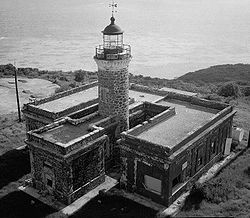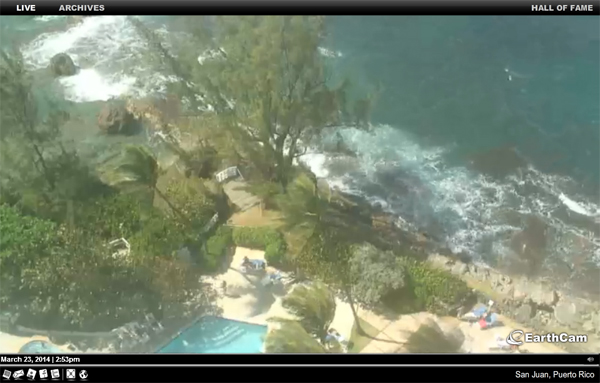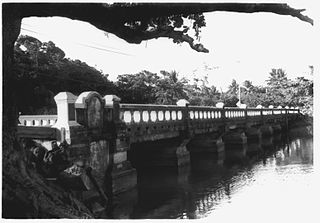 Although a July 2006 photo shows the small modern light in the shattered lantern, it is amazing that this lighthouse is in service. As of late 2000, the building is in ruins, severely damaged by vandals and by Hurricanes Hugo (1989) and Marilyn (1995). This is another lighthouse on the Lighthouse Digest Doomsday List. The building is reported to be hazardous inside. In 2003 ownership of the light station was transferred from the Culebra National Wildlife Refuge to the Municipality of Culebra. A commonwealth grant of $700,000 was reported to be available for preliminary restoration, and architects had been hired to supervise the work. June 2007 photo and an April 2008 photo show no evidence of work in progress. Located on the highest point of Culebrita, off the eastern tip of Culebra and overlooking the Virgin Passage. Accessible only by boat day tours available from Culebra, which can be reached by air from San Juan or by ferry from Fajardo). It’s a stiff hike from the beach to the lighthouse. The Culebrita lighthouse entered service on February 25, 1886. Its first keepers were Francisco Cabanellas and Pedro del Olmo. It was designed by Manuel Maese and built by the government itself on the summit of this small island because it is the highest point in the Culebra archipelago. Due to its location in an isolated, uninhabited place, the construction was very costly and difficult. Water, food and most of the construction materials had to be transported from Fajardo or Vieques. It was also difficult to hire the workers.
Although a July 2006 photo shows the small modern light in the shattered lantern, it is amazing that this lighthouse is in service. As of late 2000, the building is in ruins, severely damaged by vandals and by Hurricanes Hugo (1989) and Marilyn (1995). This is another lighthouse on the Lighthouse Digest Doomsday List. The building is reported to be hazardous inside. In 2003 ownership of the light station was transferred from the Culebra National Wildlife Refuge to the Municipality of Culebra. A commonwealth grant of $700,000 was reported to be available for preliminary restoration, and architects had been hired to supervise the work. June 2007 photo and an April 2008 photo show no evidence of work in progress. Located on the highest point of Culebrita, off the eastern tip of Culebra and overlooking the Virgin Passage. Accessible only by boat day tours available from Culebra, which can be reached by air from San Juan or by ferry from Fajardo). It’s a stiff hike from the beach to the lighthouse. The Culebrita lighthouse entered service on February 25, 1886. Its first keepers were Francisco Cabanellas and Pedro del Olmo. It was designed by Manuel Maese and built by the government itself on the summit of this small island because it is the highest point in the Culebra archipelago. Due to its location in an isolated, uninhabited place, the construction was very costly and difficult. Water, food and most of the construction materials had to be transported from Fajardo or Vieques. It was also difficult to hire the workers.
The Culebrita lighthouse is unique among local lights by its E-shape, with the tower connected on one side to the vestibule of the two keepers’ residence and on the other to the fuel deposit. The fourth-order lens projected its light twelve miles away, illuminating to the west the passage between Culebra and Puerto Rico and to the east the passage between Culebra and the Virgin Islands. The original lens was destroyed by a hurricane (San Ciprian) in 1932 and was substituted by a third-order lens. The Coast Guard boarded the building in 1959 but the U.S. Navy used it sporadically as an observation post until 1975, when an automated beacon was installed; the small plastic beacon currently used is fed by solar panels. The weather, vandalism, and a failed restoration project in 2003 have left the building in ruins. The lantern’s dome was blown away by a hurricane and lies nearby among the vegetation.



